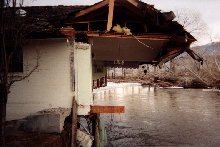|
CDC's Environmental Hazards
Epidemiology Response Program
The Health Studies Branch (HSB) of CDC's National Center for Environmental Health is
responsible for investigating the human health effects associated with exposure to
environmental hazards and to natural and technological disasters. Its primary mission is
to develop and evaluate strategies for preventing people's exposure to environmental
hazards and disasters and for minimizing the effects of such exposures when they do occur.
To accomplish this mission, HSB investigators conduct epidemiologic rapid response and
research activities with state, local, and international health agencies.
HSB Rapid Response
- Investigating the
potential health effects of exposure to dinoflagellates such as
Pfiesteria in southeastern states.
- Investigated an acute
renal failure epidemic in Haiti that caused the death of 99 children.
Found that a local brand of acetaminophen was contaminated with highly
toxic diethylene glycol.
- Investigated the
extent of exposure and toxicity among users of a
skin lotion containing mercury in New Mexico.
- Performed a rapid
needs assessment and surveillance after
Hurricane Marilyn and Hurricane Fran in North Carolina.
- Investigated the acute
health effects associated with ingesting tap water containing high
levels of copper in Delaware.
- Assessed the health of
the population affected by tornadoes in Texas.
- Investigating several
cases of lupus on the U.S.-Mexico border to see if they may be
associated with environmental exposures.

Health hazards from
flooding remain
even after the waters have receded.
HSB Research Activities
- Investigating the
potential health effects of sulfate in drinking water in several states.
- Determining risk
factors for morbidity or mortality in areas affected by natural or
technological disasters such as a Chicago heat wave that caused the
death of more than 460 people, a blizzard in Pennsylvania, and flooding
in Nevada.
- Identifying
environmental hazards that affect populations along the U.S.-Mexico
border.
- Determining the health
effects of volatile organic compound exposures to Russians living along
the Volga River, where oil spills frequently occur.
- Determining possible
health effects among Alaskan Native women exposed to environmental
chemicals that may act as endocrine disrupters.

Safe drinking water
is a major environmental
health concern worldwide.
- Measuring biological exposure levels in an Ohio community with homes sprayed with the
pesticide methyl parathion.
- Determining the health effects of air pollution and lead exposure among children in
Mexico City.
Adobe PDF File (99 KB)
Home
| Disaster
Epidemiology | Weather
Emergency Tips
Well
Water Information | Fact
Sheet
NCEH
Home|
Programs | Publications |
Contact Us | Privacy
| About NCEH
CDC Home | CDC Search | Health Topics A-Z
|


